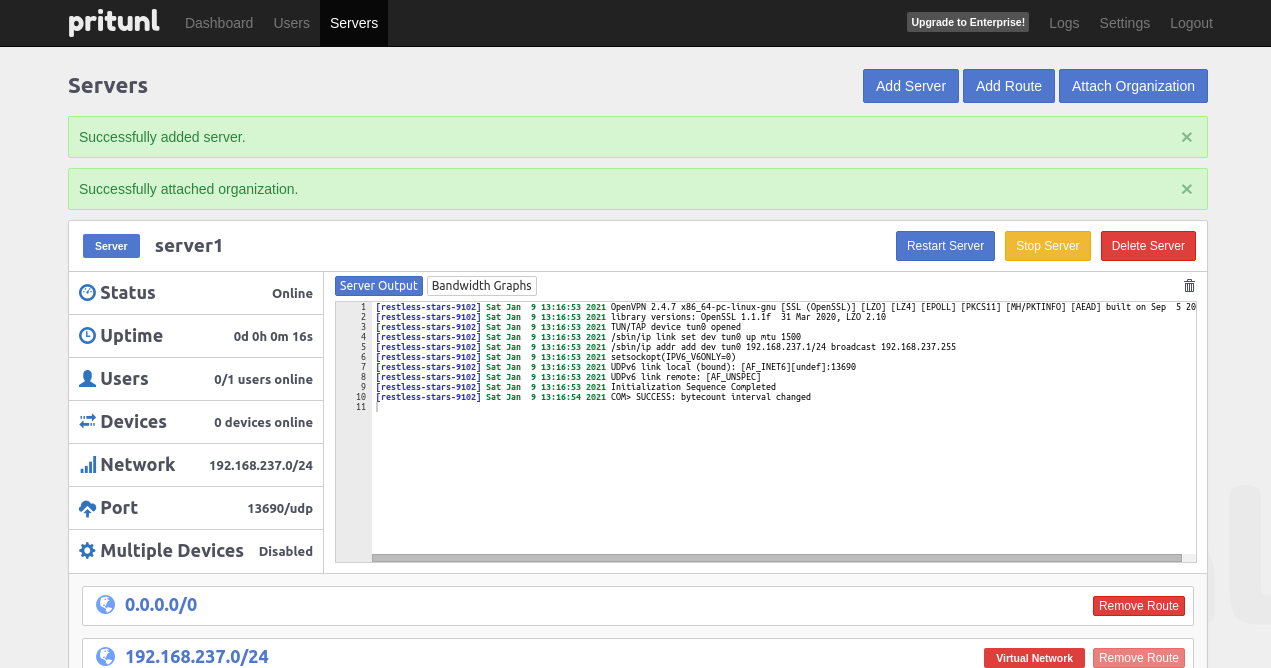

- #Pritunl server output how to#
- #Pritunl server output install#
- #Pritunl server output update#
- #Pritunl server output manual#
- #Pritunl server output free#
What it actually does is defines which IP ranges should be routed through the WireGuard VPN connection.

The AllowedIPs configuration property name is misleading.
#Pritunl server output update#
Update the AllowedIPs property to exclude LAN IP ranges. Import the configuration to the WireGuard client. Pick just one server for starters, the one that the Mullvad client chooses by default (hopefully it's one of the fastest for you).
#Pritunl server output manual#
Please note that you don't have to export all servers as the manual suggests. Export a server configuration from Mullvad and import it to the WireGuard clientĪfter log in, configuration exporting is available here: Don't worry, we got you covered!ĭownload the vanilla WireGuard client here: Their tech support recommend using the vanilla WireGuard client, but they refuse to assist configuring it. The Mullvad VPN client does not allow configuring AllowedIPS or DNS. But I was able to do it using this tutorial: Setting up a self-hosted WireGuard VPN server is wa-a-ay out of scope of this guide. Subscribe to Mullvad VPN if you haven't already or set up a self-hosted WireGuard server
#Pritunl server output install#
Python2 setup.py install -prefix=/usr/local Sudo ln -s ~/go/bin/pritunl-web /usr/bin/pritunl-web Sudo ln -s ~/go/bin/pritunl-dns /usr/bin/pritunl-dns 98, enter (per GitHub): export VERSION=.98 This should leave you in root's home directory. Make sure you are logged into your Pi and sudo to root: $ sudo su. There are a few changes from the standard PriTunl source installation instructions on GitHub. Make sure the Pi is connected to your network, then log in with username/password combination ubuntu/ubuntu.Įnter the following commands on your Pi to install a few things to prepare to compile PriTunl: $ sudo apt-get -y install build-essential git bzr python python-dev python-pip net-tools openvpn bridge-utils psmisc golang-go libffi-dev mongodb Write the image to your SD card with the following command, changing to your SD card's drive assignment (obtained in the previous step): $ dd if=ubuntu-18.04-beta-preinstalled-server-arm64+raspi3.img of= bs=8MĪfter it finishes, insert the SD card into your Pi and power it up. Enter the dmesg command and examine the last lines of the output to find out the card's drive assignment.īe VERY CAREFUL with the next step! I can't stress that enough if you get the drive assignment wrong, you could destroy your system. Your computer will assign the SD card a drive letter-something like /dev/sda or /dev/sdb. Insert the SD card you'll use with your Raspberry Pi into your desktop or laptop computer.

Unpack the download: $ xz -d ubuntu-18.04-beta-preinstalled-server-arm64+raspi3.xz Start by opening a terminal and downloading the Ubuntu 18.04 ARM64 beta release by entering: $ wget
#Pritunl server output how to#
I'll assume you have basic knowledge of how to get around the Linux command line and a Raspberry Pi. You can overcome these problems by installing a 64-bit operating system on the Raspberry Pi 3B+ before installing PriTunl. This required a complicated set of steps to install and update the necessary files to get a Raspberry Pi 3B+ to boot. Fortunately, Ubuntu's beta version of 18.04 for ARM64 boots on the Raspberry Pi 3B+.Īlso, the Raspberry Pi 3B+ uses a different bootloader from other Raspberry Pi models. I found this out when I got errors when I tried to compile PriTunl on my Raspberry Pi's 32-bit operating system. That's nothing to be afraid of it can be as simple as copying and pasting a few commands and watching the terminal for a short while.Īnother problem: PriTunl seems to require 64-bit architecture. This means you must compile your own binaries from source.

For one thing, PriTunl is supplied only as AMD64 and i386 binaries, but the 3B+ uses ARM architecture. PriTunl is generally simple to install, but this project-turning a Raspberry Pi 3B+ into a PriTunl VPN appliance-adds some complexity. Special considerations on Raspberry Pi 3B+ There is also a paid enterprise version with advanced features like Active Directory integration.
#Pritunl server output free#
It's open source, and the basic free version is more than enough to get you started and cover most simple use cases. PriTunl is a fantastic VPN terminator solution that's perfect for small businesses and individuals who want a quick and simple way to access their network privately.


 0 kommentar(er)
0 kommentar(er)
